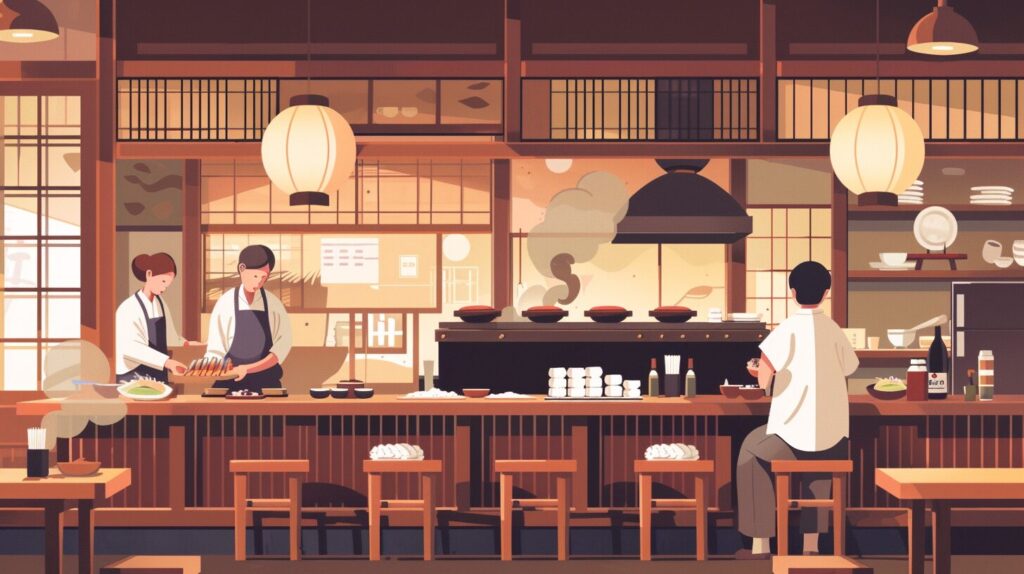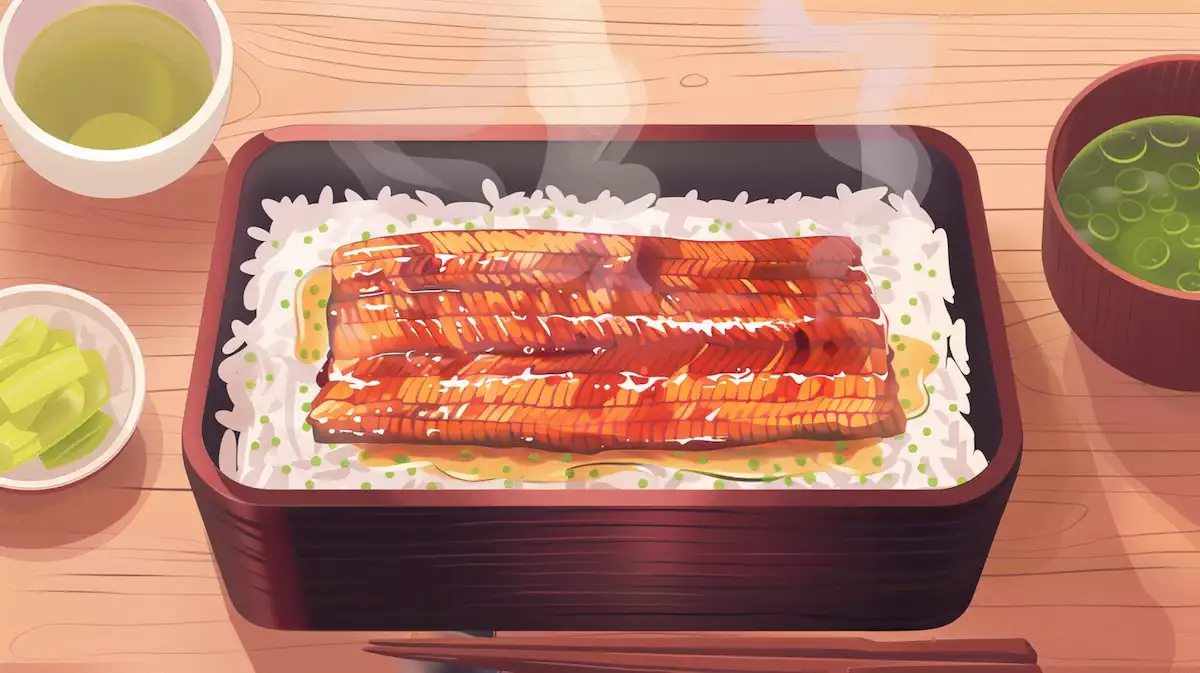うなぎの蒲焼きを英語で説明・紹介するための基本情報と、英会話に役立つ表現をシンプルでわかりやすい英語で紹介します。
英会話ダイアローグ・関連情報・10の質問を通して、うなぎの蒲焼きに関する英語表現を学びます。
英語
英会話ダイアローグを読む前に知っておくと良い前提知識と情報です。
- うなぎの蒲焼きについて:
- 日本の伝統的な料理の一つ、うなぎを焼いて特製のタレを塗った料理
- タレは主に醤油、みりん、砂糖、酒で作られ、甘辛い味わいが特徴
- 土用の丑の日:
- 夏に うなぎを食べる習慣がある特別な日
- 通常7月下旬から8月上旬頃
- 日本の地域差:
- 関東と関西で調理法が異なる
- 関東:蒸してから焼く(柔らかい食感)
- 関西:直接焼く(カリッとした食感)
- うなぎの提供方法:
- うな丼:丼(どんぶり)に盛る
- うな重:重箱に入れて出す
- うなぎの栄養価:
- タンパク質、ビタミン、オメガ3脂肪酸が豊富
- 夏バテ防止に良いとされる
- 環境問題:
- うなぎの個体数が減少している
- 価格上昇や供給量減少の原因になっている
- 日本の食文化における位置づけ:
- 高級料理の一つとして認識されている
- 特別な日や行事に食べられることが多い
- 地域特有の食べ方:
- 名古屋の「ひつまぶし」など、地域によって独自の食べ方がある
2人がうなぎの蒲焼きについて話しています。
うなぎの蒲焼きの味、調理法、文化的背景、栄養価、食べ方の地域差などを話題にしています。
また、夏に食べる習慣や、うなぎの個体数減少の問題にも触れています。
会話 / dialogue

Hey Key, I’ve been thinking about having some grilled eel tonight. I just love kabayaki! The flavor is amazing.

Oh, that sounds great! Kabayaki is one of my favorites too. The sweet and savory sauce with the rich eel is irresistible. When did you first start liking it?

I tried it a few years ago during Doyo no Ushi no Hi. People were talking about how it helps with stamina during the summer, and I thought, why not? Ever since then, I’ve been hooked! But there’s still so much I don’t know about it.

That’s cool! Kabayaki has a long history in Japan. Did you know that there are regional differences in how it’s prepared?

I didn’t know that! What’s the difference?

Well, in the Kanto region, they steam the eel before grilling it. This makes the eel softer and more tender. In Kansai, they skip the steaming and grill it directly, so it has a crispier texture. Both styles have their charm.

Interesting! I think I’ve mostly had the Kanto style, where the eel just melts in your mouth. What about the sauce? That sweet glaze is delicious!

Yes, the sauce is usually made from a mix of soy sauce, mirin, sugar, and sake. It’s brushed onto the eel multiple times while grilling, which gives it that glossy, flavorful coating. The sauce caramelizes a bit, adding even more depth to the taste.

No wonder it’s so addictive. And it’s usually served over rice, right? I’ve had it in those fancy lacquered boxes.

Exactly! That’s called unaju when it’s served in a box. If it’s served in a bowl, it’s called unadon. Both are popular, but unaju is considered a bit more luxurious.

I see. So, what’s the deal with eating it during the summer?

It’s a tradition to eat eel on Doyo no Ushi no Hi, a special day in mid-summer. It goes back to the Edo period. People believed eating eel gave them strength and helped them get through the hot summer days. Plus, eel is packed with nutrients—lots of protein, vitamins A and B, and omega-3 fatty acids.

That makes sense. I do feel more energized after eating it! It’s really nutritious. And the taste—whether it’s soft or crispy—makes it such a special dish.

Definitely. It’s also seen as a bit of a luxury these days because eel can be expensive. That’s why people often enjoy it on special occasions or treat themselves to it.

Yeah, it’s not something I eat every day. But when I do, it’s always a treat. Do you think the popularity has changed over time?

It’s still really popular, especially during the eel season. But because of its price and the fact that eel populations are declining, some people eat it less often. Still, many people in Japan consider it a special dish, and restaurants always offer it.

I didn’t know about the population decline. That’s a shame. But I can see why people love it so much—it’s delicious and deeply connected to Japanese culture.

Exactly. It’s not just food; it’s part of the culture and tradition here. If you ever get the chance, you should try both Kanto and Kansai styles to experience the different flavors.

I’d love to! I’ve only had the softer style so far, but I’m curious about the crispier Kansai version now. Maybe I’ll plan a food trip just to compare!

That sounds like a great idea! You could even try some regional variations, like hitsumabushi from Aichi, where the eel is served chopped over rice with different toppings. It’s a unique way to enjoy it.

That sounds amazing! I’m definitely adding that to my list. Thanks for all the info, Key. I’m really looking forward to my next kabayaki experience.

No problem! Enjoy your grilled eel tonight, Mack!
関連情報 / related information
「うなぎの蒲焼き」について、理解を深めるための「英語での関連情報」です。
うなぎの蒲焼き

What is Kabayaki?
Kabayaki is a traditional Japanese dish made from eel. The eel is split open, the bones are removed, and then it is grilled over a charcoal fire while being brushed with a special sauce. The sauce is a mix of soy sauce, mirin (sweet rice wine), sugar, and sake. This gives the eel a sweet and savory flavor. Kabayaki is often served over rice and is enjoyed by many people in Japan, especially during the summer.
Cooking Methods
There are different ways to cook kabayaki depending on the region in Japan. In the Kanto region (around Tokyo), the eel is steamed before it is grilled. This makes the eel softer and more tender. In the Kansai region (around Osaka), the eel is grilled directly without steaming, so it has a crispy texture. Both styles have their own unique flavor and are loved by many.
Cultural Importance
Kabayaki is traditionally eaten on a special day called “Doyo no Ushi no Hi” in summer. People believe that eating eel on this day gives them energy to fight the summer heat. Kabayaki is also considered a special dish and can be expensive. Many people enjoy it as a treat on special occasions.
Nutritional Benefits
Eel is very nutritious. It is rich in protein, vitamins A and B, and omega-3 fatty acids. These nutrients are good for health, helping to boost energy and keep the body strong, especially during the hot summer months.
10の質問 / 10 questions
「うなぎの蒲焼き」について、理解を深めるための「英語での10の質問」です。
1: What is kabayaki?
Kabayaki is a traditional Japanese dish made from eel that is grilled while being brushed with a sweet and savory sauce made from soy sauce, mirin, sugar, and sake.
2: How is kabayaki typically cooked?
The eel is split open, deboned, and grilled over a charcoal fire. In Kanto, it is steamed first to make it tender, while in Kansai, it is grilled directly for a crispier texture.
3: What makes kabayaki sauce unique?
Kabayaki sauce is a sweet and savory mixture of soy sauce, mirin, sugar, and sake. The sauce is applied multiple times while grilling to give the eel a glossy and flavorful coating.
4: Why is kabayaki eaten during the summer in Japan?
Kabayaki is often eaten during the summer, especially on Doyo no Ushi no Hi, because it is believed to give people energy and help them stay strong during the hot weather.
5: What is the difference between unaju and unadon?
Unaju is served in a lacquered box with eel placed over rice, while unadon is served in a bowl. Unaju is often considered a more luxurious version of the dish.
6: What are the nutritional benefits of eating eel?
Eel is high in protein, vitamins A and B, and omega-3 fatty acids, which help improve energy, support the immune system, and promote overall health.
7: How does kabayaki reflect Japanese culture?
Kabayaki reflects Japanese culture through its long history, seasonal traditions, and regional variations in cooking. It is a dish that brings people together for special occasions.
8: Where can you typically find kabayaki in Japan?
Kabayaki can be found in many Japanese restaurants, especially eel specialty restaurants. It is also commonly sold in supermarkets, particularly during the summer season.
9: What are some regional variations of kabayaki?
In Kanto, eel is steamed before grilling, making it tender, while in Kansai, it is grilled directly, giving it a crispier texture. In Aichi, there is a variation called hitsumabushi, where the eel is chopped and served with toppings over rice.
10: Why is eel considered a luxury food in Japan?
Eel is considered a luxury food due to its high price, which is partly because of the decline in eel populations and the complex process of preparing it. As a result, people often enjoy it on special occasions.

和訳付
会話 / dialogue

Hey Key, I’ve been thinking about having some grilled eel tonight. I just love kabayaki! The flavor is amazing.
ねえキー、今夜うなぎの蒲焼きを食べようと思ってるんだ。蒲焼きが大好きなんだよ!あの味は本当に最高だよ。

Oh, that sounds great! Kabayaki is one of my favorites too. The sweet and savory sauce with the rich eel is irresistible. When did you first start liking it?
それはいいね!蒲焼きは僕も大好きなんだ。甘辛いタレと濃厚なうなぎの組み合わせはたまらないよね。最初に好きになったのはいつ?

I tried it a few years ago during Doyo no Ushi no Hi. People were talking about how it helps with stamina during the summer, and I thought, why not? Ever since then, I’ve been hooked! But there’s still so much I don’t know about it.
数年前の土用の丑の日に食べてみたんだよ。夏にスタミナがつくってみんなが言っていて、それで試してみたら、もうやみつきさ。それ以来ずっと好きなんだけど、まだ知らないことも多いんだ。

That’s cool! Kabayaki has a long history in Japan. Did you know that there are regional differences in how it’s prepared?
それはいいね!蒲焼きには日本で長い歴史があるんだよ。調理方法に地域ごとの違いがあるって知ってた?

I didn’t know that! What’s the difference?
それは知らなかった!どんな違いがあるの?

Well, in the Kanto region, they steam the eel before grilling it. This makes the eel softer and more tender. In Kansai, they skip the steaming and grill it directly, so it has a crispier texture. Both styles have their charm.
関東では、うなぎを焼く前に蒸すんだよ。だから、うなぎが柔らかくなるんだ。でも、関西では蒸さずに直接焼くから、もっとカリッとした食感になるんだ。どちらのスタイルにも魅力があるよ。

Interesting! I think I’ve mostly had the Kanto style, where the eel just melts in your mouth. What about the sauce? That sweet glaze is delicious!
面白いね!僕が食べたのはたぶん関東スタイルだね。口の中でとろけるような感じだったよ。タレはどうなの?あの甘いコーティングがすごく美味しいよね。

Yes, the sauce is usually made from a mix of soy sauce, mirin, sugar, and sake. It’s brushed onto the eel multiple times while grilling, which gives it that glossy, flavorful coating. The sauce caramelizes a bit, adding even more depth to the taste.
そうだね、タレは通常、醤油、みりん、砂糖、酒を混ぜて作るんだ。焼いている間に何度もタレを塗ることで、あのつややかな風味豊かなコーティングができるんだよ。少しキャラメルのように濃厚になって、味に深みが増すんだ。

No wonder it’s so addictive. And it’s usually served over rice, right? I’ve had it in those fancy lacquered boxes.
だからあんなに中毒性があるんだね。普通はご飯の上に乗せて出されるよね?あの豪華な漆塗りの箱で食べたことがあるよ。

Exactly! That’s called unaju when it’s served in a box. If it’s served in a bowl, it’s called unadon. Both are popular, but unaju is considered a bit more luxurious.
その通り!箱に入っているときは「うな重」って呼ぶんだ。丼に入っている場合は「うな丼」だよ。どちらも人気だけど、うな重の方が少し高級とされているんだ。

I see. So, what’s the deal with eating it during the summer?
なるほど。それで、夏に食べる理由は何なの?

It’s a tradition to eat eel on Doyo no Ushi no Hi, a special day in mid-summer. It goes back to the Edo period. People believed eating eel gave them strength and helped them get through the hot summer days. Plus, eel is packed with nutrients—lots of protein, vitamins A and B, and omega-3 fatty acids.
夏の中頃にある土用の丑の日にうなぎを食べるのは伝統なんだよ。これは江戸時代に始まったんだ。うなぎを食べると元気が出て、暑い夏を乗り切る助けになると信じられていたんだ。それに、うなぎは栄養価が高くて、タンパク質やビタミンA、B、オメガ3脂肪酸がたくさん含まれているんだ。

That makes sense. I do feel more energized after eating it! It’s really nutritious. And the taste—whether it’s soft or crispy—makes it such a special dish.
納得だね。確かに食べた後は元気になるよ!栄養豊富だし、柔らかくてもカリッとしていても、本当に特別な料理だよね。

Definitely. It’s also seen as a bit of a luxury these days because eel can be expensive. That’s why people often enjoy it on special occasions or treat themselves to it.
そうだね。最近ではうなぎはちょっと高価だから、ちょっと贅沢なものとして見られているよ。それで特別な日に食べたり、自分へのご褒美として楽しんだりするんだ。

Yeah, it’s not something I eat every day. But when I do, it’s always a treat. Do you think the popularity has changed over time?
そうだね、毎日食べるものじゃないけど、食べるときは本当に特別な気分になるよ。人気は昔と比べて変わったと思う?

It’s still really popular, especially during the eel season. But because of its price and the fact that eel populations are declining, some people eat it less often. Still, many people in Japan consider it a special dish, and restaurants always offer it.
今でもすごく人気だよ、特にうなぎのシーズンにはね。でも、値段が高くなっているのと、うなぎの数が減ってきているので、前より頻繁には食べなくなった人もいるね。それでも、多くの人が特別な料理として考えていて、レストランでは常に提供されているよ。

I didn’t know about the population decline. That’s a shame. But I can see why people love it so much—it’s delicious and deeply connected to Japanese culture.
うなぎの減少については知らなかったよ。それは残念だね。でも、みんながそれを愛する理由はわかるよ。本当に美味しいし、日本の文化と深く結びついているもんね。

Exactly. It’s not just food; it’s part of the culture and tradition here. If you ever get the chance, you should try both Kanto and Kansai styles to experience the different flavors.
その通りだよ。うなぎは単なる食べ物じゃなくて、文化や伝統の一部なんだ。もし機会があれば、関東と関西の両方のスタイルを試して、味の違いを体験してみるといいよ。

I’d love to! I’ve only had the softer style so far, but I’m curious about the crispier Kansai version now. Maybe I’ll plan a food trip just to compare!
ぜひやってみたいね!今まで柔らかい方しか食べたことがないけど、今はカリッとした関西のスタイルにも興味があるよ。食べ比べのために旅行を計画しようかな!

That sounds like a great idea! You could even try some regional variations, like hitsumabushi from Aichi, where the eel is served chopped over rice with different toppings. It’s a unique way to enjoy it.
それはいいアイデアだね!愛知のひつまぶしみたいな地域ごとのバリエーションも試せるよ。うなぎが細かく刻まれてご飯の上に乗っていて、色んなトッピングで楽しめるんだ。とてもユニークな食べ方だよ。

That sounds amazing! I’m definitely adding that to my list. Thanks for all the info, Key. I’m really looking forward to my next kabayaki experience.
それはすごいね!絶対にリストに加えるよ。色々教えてくれてありがとう、キー。次の蒲焼きの体験が本当に楽しみになったよ。

No problem! Enjoy your grilled eel tonight, Mack!
どういたしまして!今夜のうなぎ、楽しんでね、マック!
関連情報 / related information
うなぎの蒲焼き

What is Kabayaki?
Kabayaki is a traditional Japanese dish made from eel. The eel is split open, the bones are removed, and then it is grilled over a charcoal fire while being brushed with a special sauce. The sauce is a mix of soy sauce, mirin (sweet rice wine), sugar, and sake. This gives the eel a sweet and savory flavor. Kabayaki is often served over rice and is enjoyed by many people in Japan, especially during the summer.
蒲焼きは、日本の伝統的な料理で、うなぎから作られます。うなぎを割いて骨を取り除き、炭火で焼きながら特製のタレを塗ります。このタレは、醤油、みりん、砂糖、酒を混ぜて作られ、甘辛い味わいが特徴です。蒲焼きはご飯の上に乗せて提供されることが多く、特に夏に多くの日本人に親しまれています。
Cooking Methods
There are different ways to cook kabayaki depending on the region in Japan. In the Kanto region (around Tokyo), the eel is steamed before it is grilled. This makes the eel softer and more tender. In the Kansai region (around Osaka), the eel is grilled directly without steaming, so it has a crispy texture. Both styles have their own unique flavor and are loved by many.
蒲焼きの調理方法は、日本の地域によって異なります。関東地方(東京周辺)では、うなぎを蒸してから焼くため、より柔らかくふっくらと仕上がります。一方、関西地方(大阪周辺)では、蒸さずに直接焼くため、外側がカリッとした食感になります。どちらのスタイルも独自の風味を持ち、多くの人々に愛されています。
Cultural Importance
Kabayaki is traditionally eaten on a special day called “Doyo no Ushi no Hi” in summer. People believe that eating eel on this day gives them energy to fight the summer heat. Kabayaki is also considered a special dish and can be expensive. Many people enjoy it as a treat on special occasions.
蒲焼きは、夏の「土用の丑の日」に伝統的に食べられます。この日にうなぎを食べることで、夏の暑さに対抗するエネルギーが得られると信じられています。また、蒲焼きは特別な料理とされ、価格が高いこともあります。そのため、特別な日に自分へのご褒美として楽しまれることが多いです。
Nutritional Benefits
Eel is very nutritious. It is rich in protein, vitamins A and B, and omega-3 fatty acids. These nutrients are good for health, helping to boost energy and keep the body strong, especially during the hot summer months.
うなぎは非常に栄養価が高い食材です。タンパク質、ビタミンAやB、オメガ3脂肪酸が豊富に含まれています。これらの栄養素は健康に良く、特に暑い夏の時期に体力をつけ、体を強く保つのに役立ちます。
10の質問 / 10 questions
1: What is kabayaki?
蒲焼きとは何ですか?
Kabayaki is a traditional Japanese dish made from eel that is grilled while being brushed with a sweet and savory sauce made from soy sauce, mirin, sugar, and sake.
蒲焼きは、醤油、みりん、砂糖、酒で作られた甘辛いタレを塗りながら焼いたうなぎを使った日本の伝統的な料理です。
2: How is kabayaki typically cooked?
蒲焼きは通常どのように調理されますか?
The eel is split open, deboned, and grilled over a charcoal fire. In Kanto, it is steamed first to make it tender, while in Kansai, it is grilled directly for a crispier texture.
うなぎは割いて骨を取り除き、炭火で焼かれます。関東では蒸してから焼いて柔らかく仕上げ、関西では蒸さずに直接焼いてカリッとした食感に仕上げます。
3: What makes kabayaki sauce unique?
蒲焼きのタレの特徴は何ですか?
Kabayaki sauce is a sweet and savory mixture of soy sauce, mirin, sugar, and sake. The sauce is applied multiple times while grilling to give the eel a glossy and flavorful coating.
蒲焼きのタレは、醤油、みりん、砂糖、酒を混ぜ合わせた甘辛い味が特徴です。焼いている間に何度もタレを塗り、うなぎに光沢と風味豊かなコーティングを施します。
4: Why is kabayaki eaten during the summer in Japan?
なぜ日本では夏に蒲焼きを食べるのですか?
Kabayaki is often eaten during the summer, especially on Doyo no Ushi no Hi, because it is believed to give people energy and help them stay strong during the hot weather.
蒲焼きは、特に土用の丑の日に夏に食べられることが多く、暑い季節に体力をつけ、元気を保つと信じられているためです。
5: What is the difference between unaju and unadon?
うな重とうな丼の違いは何ですか?
Unaju is served in a lacquered box with eel placed over rice, while unadon is served in a bowl. Unaju is often considered a more luxurious version of the dish.
うな重は、うなぎをご飯の上に乗せたものが漆塗りの箱で提供され、うな丼は丼に入れて提供されます。うな重はより高級なバージョンとされています。
6: What are the nutritional benefits of eating eel?
うなぎを食べることの栄養的な利点は何ですか?
Eel is high in protein, vitamins A and B, and omega-3 fatty acids, which help improve energy, support the immune system, and promote overall health.
うなぎはタンパク質、ビタミンAとB、オメガ3脂肪酸が豊富で、エネルギーの向上や免疫系のサポート、全体的な健康促進に役立ちます。
7: How does kabayaki reflect Japanese culture?
蒲焼きはどのように日本文化を反映していますか?
Kabayaki reflects Japanese culture through its long history, seasonal traditions, and regional variations in cooking. It is a dish that brings people together for special occasions.
蒲焼きは、その長い歴史、季節的な伝統、地域ごとの調理法の違いを通して日本文化を反映しています。特別な機会に人々をつなげる料理です。
8: Where can you typically find kabayaki in Japan?
日本ではどこで蒲焼きを見つけることができますか?
Kabayaki can be found in many Japanese restaurants, especially eel specialty restaurants. It is also commonly sold in supermarkets, particularly during the summer season.
蒲焼きは、多くの日本のレストラン、特にうなぎ専門店で見つけることができます。また、特に夏のシーズンにはスーパーでもよく売られています。
9: What are some regional variations of kabayaki?
蒲焼きの地域ごとのバリエーションは何ですか?
In Kanto, eel is steamed before grilling, making it tender, while in Kansai, it is grilled directly, giving it a crispier texture. In Aichi, there is a variation called hitsumabushi, where the eel is chopped and served with toppings over rice.
関東では、うなぎは焼く前に蒸されて柔らかくなり、関西では直接焼かれてカリッとした食感が特徴です。愛知県では、ひつまぶしというバリエーションがあり、うなぎが刻まれてご飯にトッピングされます。
10: Why is eel considered a luxury food in Japan?
なぜうなぎは日本では高級食品と見なされているのですか?
Eel is considered a luxury food due to its high price, which is partly because of the decline in eel populations and the complex process of preparing it. As a result, people often enjoy it on special occasions.
うなぎは高価であり、うなぎの個体数の減少と調理が複雑であることがその一因です。そのため、特別な日に楽しまれることが多いです。
words & phrases
英会話ダイアローグと関連情報に出てきた単語・フレーズです(例文は各3つ)。

savory : 形容詞
意味: 塩味のある、風味の良い。Having a salty or spicy taste rather than a sweet one.
(蒲焼きのタレの風味豊かな塩味と甘さがうまくバランスしていることを指している)
例文:
- The grilled eel had a savory and sweet flavor.
「うなぎの蒲焼きは塩味と甘さが絶妙な風味でした。」 - She prefers savory snacks over sweet ones.
「彼女は甘いものより塩味のスナックが好きです。」 - The soup had a savory taste with a hint of herbs.
「スープはハーブの風味が効いた塩味のある味でした。」
irresistible : 形容詞
意味: 抵抗できないほど魅力的な。Too attractive or tempting to be resisted.
(蒲焼きのタレと脂の乗ったうなぎが非常に魅力的で食べずにいられないことを指す)
例文:
- The aroma of the grilled eel was irresistible.
「焼かれているうなぎの香りはたまらなく魅力的でした。」 - She found the dessert irresistible and couldn’t stop eating it.
「彼女はデザートがあまりに魅力的で食べるのを止められませんでした。」 - His smile was irresistible, and everyone liked him.
「彼の笑顔は魅力的で、みんなが彼を好きになりました。」
hooked : 形容詞
意味: 夢中になって、はまっている。Addicted to or strongly attracted to something.
(蒲焼きを一度食べた後、その味に夢中になりやみつきになっていることを指す)
例文:
- After trying kabayaki, I was hooked immediately.
「蒲焼きを食べてから、すぐに夢中になりました。」 - He is hooked on video games and plays them every day.
「彼はビデオゲームに夢中で、毎日プレイしています。」 - She got hooked on that new TV series.
「彼女はその新しいテレビシリーズにはまりました。」
addictive : 形容詞
意味: 依存性がある、やみつきになる。Causing a strong craving or desire for more.
(蒲焼きがその味わいのために、一度食べたら止められなくなる性質を指す)
例文:
- The taste of kabayaki is so addictive that you can’t stop eating it.
「蒲焼きの味はとてもやみつきになり、食べるのをやめられません。」 - This new snack is addictive; I can’t stop eating it.
「この新しいスナックはやみつきで、やめられません。」 - Social media can be quite addictive if not used carefully.
「ソーシャルメディアは慎重に使わないと非常に依存性が強いことがあります。」
nutritious : 形容詞
意味: 栄養価の高い。Providing essential nutrients for good health.
(うなぎが高タンパク、ビタミン、オメガ3脂肪酸を含んでおり、体に良いことを指している)
例文:
- Eel is very nutritious, full of protein and vitamins.
「うなぎは非常に栄養価が高く、タンパク質やビタミンが豊富です。」 - Eating a nutritious breakfast is important for a healthy day.
「栄養価の高い朝食を食べることは、健康的な一日にとって重要です。」 - Vegetables and fruits are some of the most nutritious foods you can eat.
「野菜や果物は、最も栄養価の高い食品の一つです。」
詳細情報 / Further Info
関連記事(ひつまぶし)

